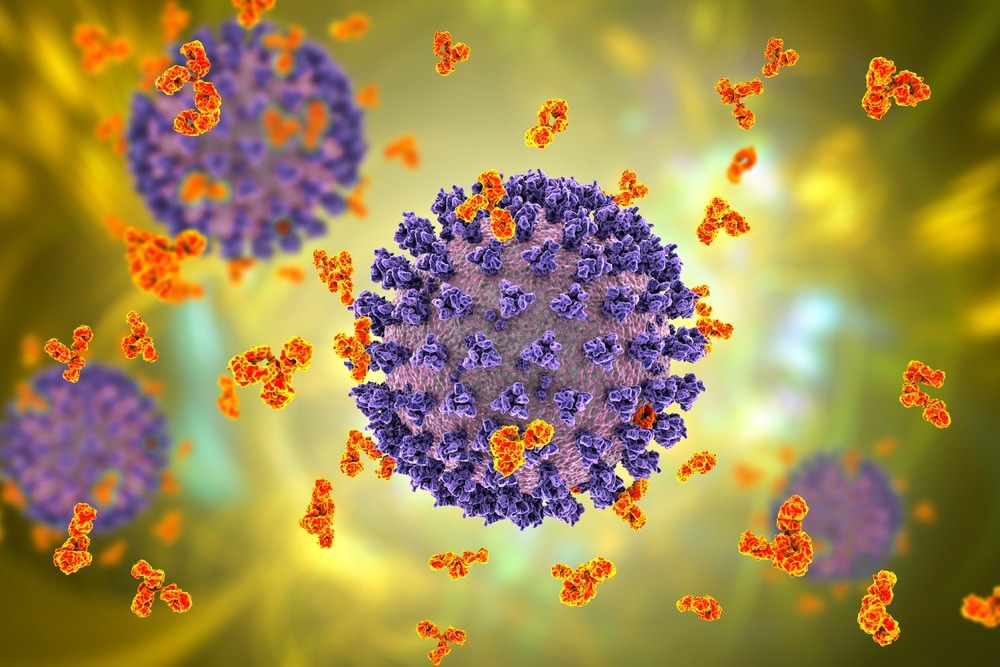In a recent study posted to the medRxiv* preprint server, researchers evaluated antibody responses to the spike (S) proteins of the severe acute respiratory syndrome coronavirus 2 (SARS-CoV-2) Wuhan-Hu-1 strain and variants of concern (VOCs) such as the Alpha, Beta, Gamma, Delta, and Omicron. They also assessed antibody responses to Omicron sub-VOCs such as BA.1 sub-VOC, BA.4/5 sub-VOC, BA.2.75 sub-VOC, and Omicron BA.2.12.1 sub-VOC.

Study: Fully Quantitative Measurements of Differential Antibody Binding to a Spectrum of SARS-CoV-2 Spike Proteins: Wuhan, Alpha, Beta, Gamma, Delta, Omicron BA.1, BA.4, BA.5, BA.2.75 and BA.2.12.1. Image Credit: Kateryna Kon/Shutterstock

 *Important notice: medRxiv publishes preliminary scientific reports that are not peer-reviewed and, therefore, should not be regarded as conclusive, guide clinical practice/health-related behavior, or treated as established information.
*Important notice: medRxiv publishes preliminary scientific reports that are not peer-reviewed and, therefore, should not be regarded as conclusive, guide clinical practice/health-related behavior, or treated as established information.
Background
The predominance of Omicron sub-VOCs has led to bivalent messenger ribonucleic acid (mRNA) vaccine development to produce antibodies against Wuhan-Hu-1, and the Omicron sub-VOCs, BA.1 and BA.5 by Moderna and Pfizer vaccines, respectively.
The authors previously identified several immune endotypes based on antibody-S protein interactions and reported a universal immune endotype, U(+), exhibiting cross-reactive antibodies to the conserved Achilles epitope. A probable hinge site was identified on SARS-CoV-2 S, essential to bind with the angiotensin-converting enzyme 2 (ACE2) receptor, critical for SARS-CoV-2 entry into the host. Antibodies to the epitope showed cross-reactivity since hinge mutations could lead to complete functional loss.
About the study
In the present study, researchers evaluated humoral responses against Wuhan-Hu-1, Alpha, Beta, Gamma, Delta, and Omicron, including Omicron sub-VOCs such as BA.1 sub-VOC, BA.4/5 sub-VOC, BA.2.75 sub-VOC, and Omicron BA.2.12.1 sub-VOC by performing a fully quantitative endotype analysis using biophotonic multiplexed immunoassays.
The analysis was extended for all aforementioned strains to assess the Achilles epitope conservation for the universal U(+) endotype and the Omicron dropout immunological endotype incidence.
Immunological profiles were assessed for individuals from four cohorts: the pre-pandemic cohort, the Wuhan-Hu-1 strain(+) cohort, two cohorts of vaccinees: one cohort of two-dose Pfizer and/or AZ (AstraZeneca) vaccinees, and another cohort of three-dose vaccinees who received known vaccines, with immunity derived from vaccinations only, or from prior coronavirus disease 2019 (COVID-19).
The biophotonic multiplexed platform used the localized particle-type plasmon resonance concept in an application that sensed anti-SARS-CoV-2 antibodies. The assays were calibrated against NISTmAb (RM8671), a humanized and recombinant immunoglobulin (Ig)G1ĸ with a sequence specific to the respiratory syncytial virus F protein (RSVF). The S protein calibration Ig antibody targeted a site in the S protein subunit 2 (S2) for assessing variant protein integrity.
Seventeen pre-pandemic (before December 2019), polymerase chain reaction (PCR)(-), and 11 positive samples from PCR(+) individuals were obtained. In addition, 26 samples of PCR(+) and anti-SARS-CoV-2 IgG-positive individuals were obtained before June 2020. Samples were also obtained from 96 patients attending clinics. Of these, 13 individuals were one-dose Pfizer or AZ vaccinees, 41 were two-dose Pfizer, Moderna, or AZ vaccinees, who received vaccine doses ≥2.0 weeks before sample collection, and 41 were three-dose vaccinees.
Results
The U(+) endotype was observed with significant humoral responses to all strains tested with an 11% incidence among Wuhan-Hu-1(+) individuals, directly challenging the ‘one-and-done’ immunological claim, while 53% of patients presented with ≥1.0 dropouts. The most prevalent U(±) was a triple dropout, β/γ/δ(-). The universal endotype incidence rates were 22.0% and 54.0% among two-dose vaccinees among three-dose vaccinees, respectively.
The remaining individuals of every cohort showed a wide range of humoral responses, with a few dropout immunological endotypes and the universal endotype with poor humoral responses to ≥1.0 SARS-CoV-2 strains. AZ vaccinees showed U[(1-8)-] dropouts dominated by U(5-), including the Omicron sub-VOCs. In comparison, Pfizer vaccinees showed only U(1-4) comprising a mixture of all SARS-CoV-2 strains. Among three-dose vaccinees, the higher-order dropouts were almost eliminated with no ≥U(5).
The U(±) incidence rate among three-dose vaccinees was 41.0%, indicating individuals with poor sterilizing sera might not eliminate SARS-CoV-2, leading to the persistence of SARS-CoV-2 persistence and mobile-type microcolonies, which might provide pathophysiological pathways for long COVID symptomatology. The pre-vaccine SARS-CoV-2 infection cohort showed median antibody titers for Wuhan-Hu-1 and S protein VOCs, which were greater among two-dose and three-dose vaccinees.
The pre-pandemic, negative control samples were 81.0% negative for anti-S antibodies or unclassified, with two individuals demonstrating a β/γ/δ dropout, indicative of humoral immunity against the Wuhan-Hu-1 strain and the Omicron sub-VOCs, potentially due to a misclassification: the PCR false-positive rate was 4.0%. However, a significantly larger spectrum of antibody responses was observed for Wuhan-Hu-1(+) individuals,two-dose vaccinated and three-dose vaccinated cohorts.
Conclusions
Overall, the study findings showed the humoral immunity spectrum with the universal endotype to the conserved Achilles epitope prevalence across all SARS-CoV-2 strains, pointing towards the development of a universal therapeutic agent or vaccine against SARS-CoV-2.
However, less encouragement is obtained from the universal endotype incidence of 41.0%, indicating that 67% of the population might have an immunological endotype that would not protect. It might even permit SARS-CoV-2 to persist with non-sterilizing sera.
A smartly designed booster vaccination campaign with different vaccines might be needed to break the immunological imprint by selecting heterologous sequences of vaccines, including novel whole-virus and bivalent vaccines.

 *Important notice: medRxiv publishes preliminary scientific reports that are not peer-reviewed and, therefore, should not be regarded as conclusive, guide clinical practice/health-related behavior, or treated as established information.
*Important notice: medRxiv publishes preliminary scientific reports that are not peer-reviewed and, therefore, should not be regarded as conclusive, guide clinical practice/health-related behavior, or treated as established information.